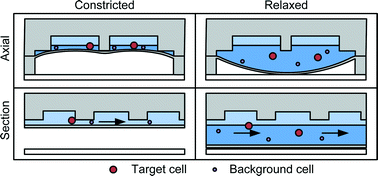Clog-free cell filtration using resettable cell traps†
Abstract
The separation of cells by filtration through microstructured constrictions is limited by clogging and adsorption, which reduce selectivity and prevent the extraction of separated cells. To address this key challenge, we developed a mechanism for simply and reliably adjusting the cross-section of a microfluidic channel to selectively capture cells based on a combination of size and deformability. After a brief holding period, trapped cells can then be released back into flow, and if necessary, extracted for subsequent analysis. Periodically clearing filter constrictions of separated cells greatly improves selectivity and throughput, and minimizes adsorption of cells to the filter microstructure. This mechanism is capable of discriminating cell-sized polystyrene microspheres with <1 μm resolution. Rare cancer cells doped into leukocytes can be enriched ~1800× with ~90% yield despite a significant overlap in size between these cell types. An important characteristic of this process is that contaminant leukocytes are captured by non-specific adsorption and not mechanical constraint, enabling repeated filtration to improve performance. The throughput of this mechanism is 900 000 cells per hour for 32 multiplexed microchannels, or ~1 200 000 cells cm−2 h−1 on a per area basis, which exceeds existing micropore filtration mechanisms by a factor of 20.

- This article is part of the themed collection: 2014 Lab on a Chip Emerging Investigators

 Please wait while we load your content...
Please wait while we load your content...